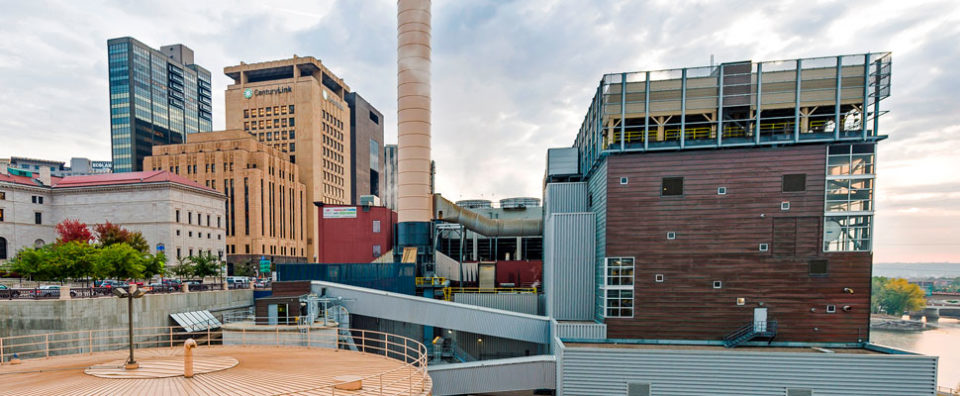Over the last 10 years, Ever-Green Energy has experienced considerable growth, taking on utility operations and management in Milwaukee and Duluth and welcoming new clients looking to advance system efficiency and sustainability throughout North America. With so many new opportunities, we are proud that our flagship system in Saint Paul has kept its momentum on advancing efficiency and living up to our core value of environmental stewardship. While the biggest news for our organization has been the coal retirement this spring, this milestone is among many improvements at District Energy St. Paul both this past year and planned for the future.
Farewell to Coal

At the end of March 2019, District Energy retired coal from heating operations, two years earlier than planned. Between 2000 and 2017, District Energy had already reduced carbon emissions for the heating system by 57 percent, mostly through the integration of the biomass-fired combined heat and power plant and systematic reduction in coal usage. While much of Minnesota relies on natural gas or fuel oil, District Energy heating services have been nearly 50-percent renewable since 2003, using wood waste from the region to generate renewable electricity for Xcel Energy and provide heat for the downtown district system.
Eliminating coal reduces the heating system’s CO2 emissions by an additional 16 percent or 10,000 tons per year—the equivalent of removing 2,100 cars from the road each year. In the short-term, this will mean using natural gas to supplement the biomass-fired CHP, but we see natural gas as a bridge to future solutions that can reduce the carbon profile further. Achieving future reductions will come from a mix of customer and plant efficiency measures, reduction in distribution temperatures, and incorporation of renewables. Read more about the coal announcement on District Energy’s news page.
Optimizing Cooling
 Environmental stewardship can certainly mean incorporating renewable fuels, but we also know making a difference means saving every kilowatt and BTU possible and staying committed to a strategy that prioritizes reliability and efficiency. To improve the efficiency and delivery of our cooling services, we have focused on several key projects:
Environmental stewardship can certainly mean incorporating renewable fuels, but we also know making a difference means saving every kilowatt and BTU possible and staying committed to a strategy that prioritizes reliability and efficiency. To improve the efficiency and delivery of our cooling services, we have focused on several key projects:
- Improved controls system protocols have allowed us to make better use of our two chilled water storage tanks. By dispatching the chilled water from the tanks later in the day, we are addressing the customer building heat gain at its highest while avoiding the grid’s peak electricity demand. All of these efforts allow us to avoid starting up additional chillers in our fleet during the heat of the day and, instead, make chilled water at night when the conditions are more favorable to efficient production and electricity costs are low.
- Optimized operations have allowed us to eliminate unnecessary electrical usage. This included setting the cooling tower basin temperature based on the outside wet bulb temperature, which enables cooling tower fans to automatically modulate and run at lower speeds, while still maintaining optimal chiller performance. We also overhauled the cooling towers, which helps the towers provide more cooling with less electric load.
- The addition of a new chiller to our operations increases the efficiency of chilled water operations. It also lessens our environmental impact by using a refrigerant that has at least 100 times less global warming potential than commonly used refrigerants. This refrigerant is also rendered effectively neutral in just 26 days — years less than most refrigerants.
- Through a multi-year educational effort focused on optimizing customer cooling efficiency coupled with our new customer analytics and efficiency program, our customers’ peak demand for cooling has been reduced from previous years by about 30 percent, allowing us to cool more customer spaces with less energy and save money for our customers.
The District Energy Director of Production, Chris Peterson, presented on these results at the International District Energy Association’s 2019 Campus Conference. Access the presentation here.
A Sustainable Future
Eliminating coal and increasing cooling efficiency are just two components of a multi-faceted plan for District Energy to provide customers with more sustainable energy solutions — an expectation that has increased in the last decade. District Energy is in the planning stages for several innovative technology solutions to reduce the system’s carbon footprint. The company is establishing a new sustainability platform, which will set the stage for improving water usage, increasing system efficiency and renewable integration, and reducing carbon throughout all of our operations.
District Energy President and CEO, Ken Smith, says it best when thinking about what our future holds.
“As a leading community utility, we have the responsibility of providing reliable and cost-effective services to our customer. We must also be looking ahead to the integration of emerging technology solutions that benefit our customers and the environment. District Energy is in the process of setting new, ambitious sustainability goals that will continue to advance the system and further reduce our CO2 emissions.”

